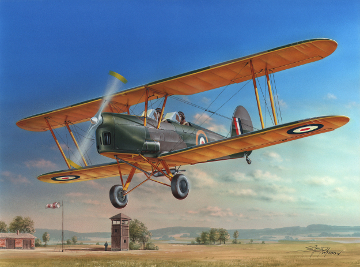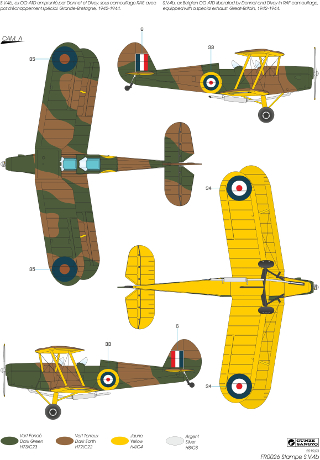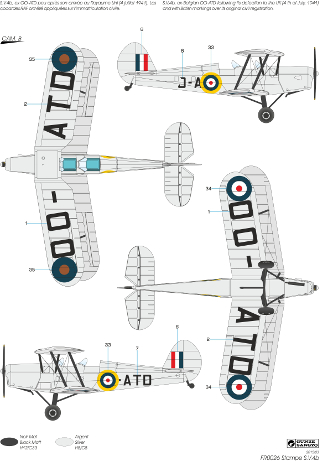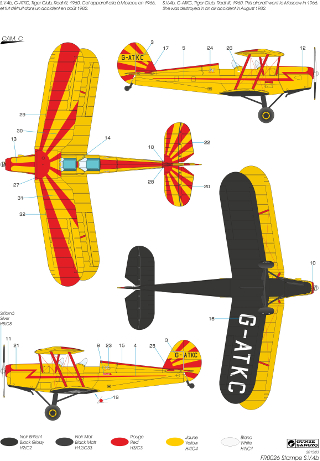FR0026 Stampe S.V.4b United Kingdom
History:
The Stampe et Vertongen S.V.4 is probably one of the Belgian aeronautical industry‘s most outstanding successes. Jean Stampe’s aim was to design a training plane with very good aerobatic capabilities, which as the SV4’s career proves, is something that he did very well.

The Stampe S.V.4b (“b” for bis or second version) prototype was registered as OO-ATC. It won competitions held by the Belgian Aéronautique Militaire and the French Armée de l’Air, which were both held in the summer of 1939. The Belgians ordered thirty planes for their air force, delivered between December 1939 and May 1940. Michel Donnet and Léon Divoy later “liberated” the prototype backup, registered as OO-ATD, on July 4th 1941, and used it to escape from occupied Belgium to England where it was camouflaged with a RAF pattern. This plane was fitted with a modified exhaust for a special duty mission, although this was later cancelled.
The French and Belgian air forces both lacked training aircraft following WWII. In 1947, Belgium ordered sixty-five of the S.V.4b version, although these differed slightly from the pre-war version, being fitted with a more powerful Gipsy Major X engine and having a removable sliding canopy. France initially ordered 701 SV4’s powered by a 4-POI Renault engine built under licence in Sartrouville, and then ordered 150 more units to be built in Algeria. The Renault powered version was designated Stampe S.V.4c.
Stampes, although used primarily for liaison duties and elementary training, also won many international aerobatics competitions. France and Belgium sold Stampes to clubs and individuals who still use them nowadays. The owners and enthusiasts of this remarkably successful design are supported by the “Stampe Club”.
The UK’s Tiger Club uses Stampes for aerial shows, and one of these planes, a S.V.4b registered as G-ATKC, even went to Moscow in 1968. Douglas Bianchi used Stampes with slight modifications to play the role of WWI fighters in movies like Aces High. Stampes are very popular in the UK where their colourful old biplane layout and colourful liveries still attract attention.
Specs: Single engined two-seat aerobatic capable trainer biplane. Wingspan: 8,39 m (upper wing) and 8 m (lower wing), length 6,97 m, wing area 8,06 m2, weight (empty) 529 kg, maximum weight 770 kg. With a Renault 4-PO3 engine, maximum speed at sea level 198 km/h.
Additional information, documentation:
- All boxes contain two common plastic sprues, including two cowlings (Gipsy and Renault) and transparent parts for all versions (2 windshields for the open cockpit version, one closed canopy for the standard belgian version, and one for the Manchots aerobatic team) as well as a commmon resin sprue giving two Venturis, two humps for version a (allows to go from version c to version a, aerobatics) and one Pitot tube. A specific resin part is added, when needed (special exhaust for cam A in this box)
- Documentation : Les avions Stampe, Réginald Jouhaud (Wimpel Amsterdam), and the Ouest France booklet, also from Reginald Jouhaud
- A build of OO-ATD in KIT, the IPMS Belgium magazine, Nr 183 (Vol 46 n°3), february 2017. It seems that Donnet and Divoy, on the 4th of July 41, had to find and install some navigational instruments in the dashboard, the original instruments having been removed. Even more remarkable, and very interesting.
Camouflage schemes:
- In RAF camouflage, aircraft borrowed by Donnet and Divoy to escape to England, fitted with the modified exhaust (box art)
- Same aircraft shortly after arrival in England still partly registered OO-ATD, with RAF roundels
- G-ATKC, used by Tiger Club


